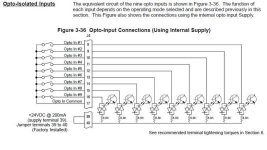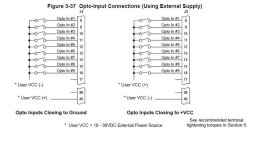You are using an out of date browser. It may not display this or other websites correctly.
You should upgrade or use an alternative browser.
You should upgrade or use an alternative browser.
Sourcing & Sinking
- Thread starter pkb2050
- Start date
We over here in Europe don't. So it's a regional thing. You could also ask why in some countries they drive on the left side on the road, while in other countries they drive on the right side.I want to know why we prefer Sourcing at Input and Sinking at output ?
Regards,
Last edited:
metwally.mustafa
Member
what is the difference between sourcing and sinking in case of servo drives?
The same as with PLC inputs and outputs.what is the difference between sourcing and sinking in case of servo drives?
Regards,
Hello Mustafa;
The terminologies "sourcing" and "sinking" apply to the status and wiring of digital inputs and outputs.
The following FAQ form Siemens might give you insights into the distinctions:
http://support.automation.siemens.com/WW/view/en/23451499
So if you are connecting between the PLC and the servo using digital signals you might have to refer to these definitions. If not, they are not applicable.
Hope this helps,
Daniel Chartier
The terminologies "sourcing" and "sinking" apply to the status and wiring of digital inputs and outputs.
The following FAQ form Siemens might give you insights into the distinctions:
http://support.automation.siemens.com/WW/view/en/23451499
So if you are connecting between the PLC and the servo using digital signals you might have to refer to these definitions. If not, they are not applicable.
Hope this helps,
Daniel Chartier
Mickey
Lifetime Supporting Member
Hello Mustafa;
The terminologies "sourcing" and "sinking" apply to the status and wiring of digital inputs and outputs.
The following FAQ form Siemens might give you insights into the distinctions:
http://support.automation.siemens.com/WW/view/en/23451499
So if you are connecting between the PLC and the servo using digital signals you might have to refer to these definitions. If not, they are not applicable.
Hope this helps,
Daniel Chartier
Here's another link for you.
http://www.patchn.com/index.php?option=com_content&task=view&id=57&Itemid=74
metwally.mustafa
Member
thank you Mr.Mickey
and thank you Mr.Dchartier
and thank you Mr.Dchartier
Mickey
Lifetime Supporting Member
thank you Mr.Mickey
and thank you Mr.Dchartier
Your welcome
peoplehouse
Member
Hello, if you don't mind I would like to ask another question about source and sink. I'm trying to understand how that applies to VFD's that are switchable, would you always want to use sinking?
Thanks,
Jeff
Thanks,
Jeff
nonuke
Member
- Join Date
- Sep 2005
- Posts
- 840

Hello, if you don't mind I would like to ask another question about source and sink. I'm trying to understand how that applies to VFD's that are switchable, would you always want to use sinking?
Thanks,
Jeff
If you want to start/stop the VFD directly from the PLC output, then you have to select the correct type of input in the VFD to match the PLC output (source or sink).
peoplehouse
Member
Thank you Nonuke but I'm totally missing something. I've looked at Mickey's link again and totally understand how that works with photo cells. I just don't get why we would set up a drive to source. I've got some research to do.
Thanks again
Jeff
Thanks again
Jeff
SMOKE
Member
In my experience most places source because someone can (want) take a volt meter and look for power. Guess there Ohms position don't work. I always buy and use source I/O just for maintenance peoples. Every VFD I have used can source or sink. If it is just the VFD and a push button I stick with the sink option. (if you link the commons of 1 VFD you can source from the +VDC of 1 VFD) When its part of a system and you are linking them many all together with your common. I source. I think Europe is big on sinking and I would like to do that also.
I have been installing a new system 12 hours + day 10.
I think I didn't answer the question.
I have been installing a new system 12 hours + day 10.
I think I didn't answer the question.
sthompson
Lifetime Supporting Member + Moderator
Thank you Nonuke but I'm totally missing something. I've looked at Mickey's link again and totally understand how that works with photo cells. I just don't get why we would set up a drive to source. I've got some research to do.
Thanks again
Jeff
If your PLC Output was a Sourcing type. Lets say 24VDC Sourcing, which is common. You would have to set your VFD Inputs to Sinking. If your PLC Output was a Sinking type, you would have to set your VFD Inputs to Sourcing.
Sourcing Outputs pull the voltage up to the Output Card Supply Positive Voltage (V+). Sinking Outputs pull the Output Voltage to the Output Card Supply Common or Negative (V-).
Sinking Inputs expect a Positive Input Voltage, and the Inputs Common Rail is connected to V-. Sourcing Inputs expect to be pulled to Common (V-), and the Inputs Common is connected to V+.
The most common in my experience is Sourcing Outputs and Sinking Inputs. I only use Sinking Outputs, or Sourcing Inputs, when I have no other choice due to the equipment I have to connect to.
There is usually a diagram in the VFD Manual showing the typical configuration. It basically consists of an Optoisolator for each Input with one side connected to the Input Terminal, and the other side connected to the Common Rail. Many VFDs will allow you to user either Sourcing or Sinking depending wether you connect V+ (Sourcing Input from Sinking PLC Output) or V- (Sinking Input from Sourcing PLC Output) to the Common Rail. The V+ or V- connection to the Common Rail insures that Current flows in the correct direction through the Optoisolators internal LED.
If you connect a VFD's Inputs directly to a PLC or other device. There is usually a jumper to the VFD's Internal Supply for use with Push Buttons, or Volts Free Contacts. This should be removed when the VFD is used with a PLC etc. This should be documented in the VFD's Manual.
I hope that helps clear it up some.
Stu......
Roy Matson
Member
Last edited:
sthompson
Lifetime Supporting Member + Moderator
Good idea Roy, this is one that I grabbed out of a VFD PDF Manual. Unfortunately, I didn't have it handy last night. You can see the Common Rail for all the Inputs, the two opposite Polarity LEDs with Current Limiting Resistor, and the Factory Installed Jumper.
The second image shows the connections if you are going to use external control.
Stu.....


The second image shows the connections if you are going to use external control.
Stu.....


Last edited:
Similar Topics
Good morning all.
I have never seen this done but I want to ask if it is possible. On an AB 1766-L32BWA, can you have some of the inputs wired as...
- Replies
- 8
- Views
- 2,357
I have a client who has installed a control system which was designed offshore (ASIA), and uses a power system common to the Asian market.
The DC...
- Replies
- 3
- Views
- 1,923
Hi there,
I have a 2 wire npn sensor. For example in this diagram:
I'm guessing i should connect it to a PLC dc sourcing input as such? Would...
- Replies
- 5
- Views
- 5,210
Hello again guys,
I've read tons of informations on sinking and sourcing inputs and outputs, however there is something bugging me with this.
I...
- Replies
- 15
- Views
- 4,350
We are some students thinking of buying a logo!8 starterkit to connect diffuse photosensores to the digital input. some of the sensores already in...
- Replies
- 2
- Views
- 3,299






